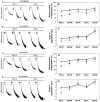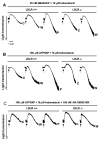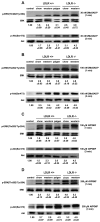Contribution of the P2Y12 receptor-mediated pathway to platelet hyperreactivity in hypercholesterolemia
- PMID: 21261805
- PMCID: PMC3071452
- DOI: 10.1111/j.1538-7836.2011.04217.x
Contribution of the P2Y12 receptor-mediated pathway to platelet hyperreactivity in hypercholesterolemia
Abstract
Background: In hypercholesterolemia, platelets demonstrate increased reactivity and promote the development of cardiovascular disease.
Objective: This study was carried out to investigate the contribution of the ADP receptor P2Y12-mediated pathway to platelet hyperreactivity due to hypercholesterolemia.
Methods: Low-density lipoprotein receptor-deficient mice and C57Bl/6 wild-type mice were fed on normal chow and high-fat (Western or Paigen) diets for 8 weeks to generate differently elevated cholesterol levels. P2Y12 receptor-induced functional responses via G(i) signaling were studied ex vivo when washed murine platelets were activated by 2MeSADP and PAR4 agonist AYPGKF in the presence and absence of indomethacin. Platelet aggregation and secretion, α(IIb)β(3) receptor activation and the phosphorylation of extracellular signal-regulated protein kinase (ERK) and Akt were analyzed.
Results: Plasma cholesterol levels ranged from 69 ± 10 to 1011 ± 185 mg dL(-1) depending on diet in mice with different genotypes. Agonist-dependent aggregation, dense and α-granule secretion and JON/A binding were gradually and significantly (P < 0.05) augmented at low agonist concentration in correlation with the increasing plasma cholesterol levels, even if elevated thromboxane generation was blocked. These functional responses were induced via increased levels of G(i) -mediated ERK and Akt phosphorylation in hypercholesterolemic mice vs. normocholesterolemic animals. In addition, blocking of the P2Y12 receptor by AR-C69931MX (Cangrelor) resulted in strongly reduced platelet aggregation in mice with elevated cholesterol levels compared with normocholesterolemic controls.
Conclusions: These data revealed that the P2Y12 receptor pathway was substantially involved in platelet hyperreactivity associated with mild and severe hypercholesterolemia.
© 2011 International Society on Thrombosis and Haemostasis.
Conflict of interest statement
The authors state that they have no conflict of interest.
Figures





Similar articles
-
P2Y12 receptor-mediated potentiation of thrombin-induced thromboxane A2 generation in platelets occurs through regulation of Erk1/2 activation.J Thromb Haemost. 2006 Mar;4(3):638-47. doi: 10.1111/j.1538-7836.2006.01789.x. J Thromb Haemost. 2006. PMID: 16460446
-
Protease-activated receptors 1 and 4 do not stimulate G(i) signaling pathways in the absence of secreted ADP and cause human platelet aggregation independently of G(i) signaling.Blood. 2002 May 15;99(10):3629-36. doi: 10.1182/blood.v99.10.3629. Blood. 2002. PMID: 11986217
-
The effect of P2Y12 inhibition on platelet activation assessed with aggregation- and flow cytometry-based assays.Platelets. 2017 Sep;28(6):567-575. doi: 10.1080/09537104.2016.1246713. Epub 2016 Nov 25. Platelets. 2017. PMID: 27885904
-
P2Y12 ADP receptor-dependent tyrosine phosphorylation of proteins of 27 and 31 kDa in thrombin-stimulated human platelets.Thromb Haemost. 2005 May;93(5):880-8. doi: 10.1160/TH04-09-0612. Thromb Haemost. 2005. PMID: 15886804
-
The role of ADP receptors in platelet function.Front Biosci. 2006 May 1;11:1977-86. doi: 10.2741/1939. Front Biosci. 2006. PMID: 16368572 Review.
Cited by
-
Association of ADP-Induced Whole-Blood Platelet Aggregation with Serum Low-Density Lipoprotein Cholesterol in Patients with Coronary Artery Disease When Receiving Maintenance Ticagrelor-Based Dual Antiplatelet Therapy.J Clin Med. 2023 Jul 6;12(13):4530. doi: 10.3390/jcm12134530. J Clin Med. 2023. PMID: 37445565 Free PMC article.
-
The Signaling Pathway of the ADP Receptor P2Y12 in the Immune System: Recent Discoveries and New Challenges.Int J Mol Sci. 2023 Apr 4;24(7):6709. doi: 10.3390/ijms24076709. Int J Mol Sci. 2023. PMID: 37047682 Free PMC article. Review.
-
Current Strategies to Guide the Antiplatelet Therapy in Acute Coronary Syndromes.Int J Mol Sci. 2024 Apr 3;25(7):3981. doi: 10.3390/ijms25073981. Int J Mol Sci. 2024. PMID: 38612792 Free PMC article. Review.
-
Dichloroacetate, an inhibitor of pyruvate dehydrogenase kinases, inhibits platelet aggregation and arterial thrombosis.Blood Adv. 2018 Aug 14;2(15):2029-2038. doi: 10.1182/bloodadvances.2018022392. Blood Adv. 2018. PMID: 30108111 Free PMC article.
-
Cardiovascular and genetic determinants of platelet high responsiveness: results from the Gutenberg Health Study.Blood Adv. 2024 Aug 13;8(15):3870-3874. doi: 10.1182/bloodadvances.2023012538. Blood Adv. 2024. PMID: 38776438 Free PMC article.
References
-
- Carvalho AC, Colman RW, Lees RS. Platelet function in hyperlipoproteinemia. N Eng J Med. 1974;290:434–38. - PubMed
-
- Tremoli E, Colli S, Maderna P, Baldassarre D, Di Minno G. Hypercholesterolemia and platelets. Semin Thromb Hemost. 1993;19:115–21. - PubMed
-
- Ferroni P, Basili S, Davi G. Platelet activation, inflammatory mediators and hypercholesterolemia. Curr Vasc Pharmacol. 2003;1:157–69. - PubMed
-
- Lacoste L, Lam JY, Hung J, Letchacovski G, Solymoss CB, Waters D. Hyperlipidemia and coronary disease. Correction of the increased thrombogenic potential with cholesterol reduction. Circulation. 1995;92:3172–7. - PubMed
Publication types
MeSH terms
Substances
Grants and funding
LinkOut - more resources
Full Text Sources
Medical
Research Materials
Miscellaneous

